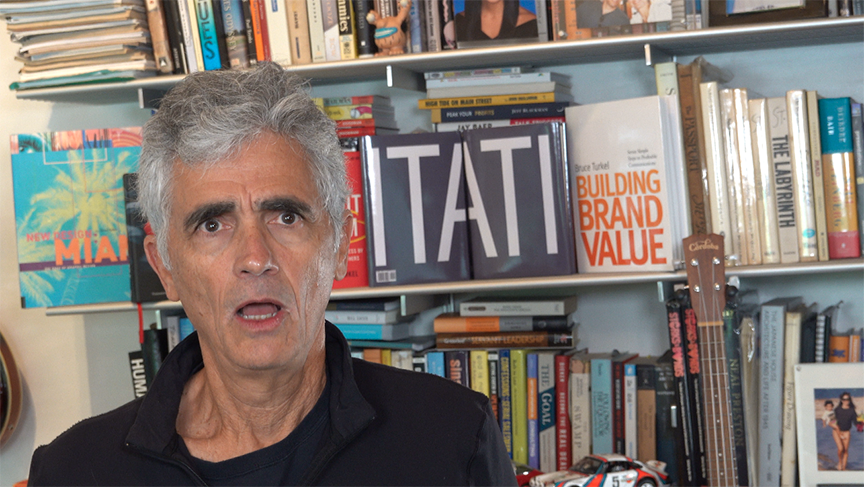Click HERE to watch the video.
About two thirds of the way through facilitating a brand ideation session for a client in Tampa, I asked the people around the table what they thought we should call their new service?
The woman on my left almost leapt out of her seat. “Movin' On Up” she said with excitement.
Hearing that, at least five of us instantly launched into a painfully out of tune a cappella version of the theme song from The Jefferson's:
“We're movin' on up, to the Eastside. To a de-luxe apartment in the sky…”
From there, our outburst encouraged a group stream of consciousness that pachinkoed from The Jefferson's to Norman Lear to Lear's ex-wife to the magazine someone remembered she started after divorcing her husband. No one could quite remember her name, so we looked it up on Google.
Norman Lear's ex-wife's name was Frances… Frances Lear. But that wasn't her original name – she was born with only a first name, and it wasn't even Frances. Here's what Wikipedia says about her:
“Lear was born with only a first name, Evelyn, to an unwed mother in Hudson, NY, at the Vanderheusen Home for Wayward Girls. She was adopted at 14 months by Aline and Herbert Loeb from Larchmont, NY, who changed her name from Evelyn to Frances. When she was 10 years old, her adoptive father committed suicide after losing his business in the Depression. Her mother remarried and when Frances was 12, her stepfather began molesting her, according to her autobiography.”
OMG!! Who knew??!!
Every line off that first Wikipedia paragraph unfolds like page after page of a gas station map, with the points of interest on each panel highlighted with little illustrations. All of a sudden, Frances Lear went from someone we thought we had maybe heard of to someone we had to know more about. Why?
The power of stories.
American mythologist and writer Joseph Campbell was best known for his ideas on the power of stories and myths throughout history. According to Campbell's theory, mankind uses stories to create drama, explain the unknown, encourage action, and help the listener make sense of the world.
Famous tales, from the story of Jesus and popular blockbusters including Star Wars, Lord of the Rings, and The Matrix, all follow the pattern of Campbell's “Hero's Journey.”
But more than religion and entertainment benefit from the structure that Campbell diagramed. Businesses, too, create mythologies about their founders and products to help create understanding of, and desire for, their products and services. Think Richard Branson, Steve Jobs, Martha Stewart, Bill Gates, Estee Lauder, and Elon Musk to understand this.
According to Professor Noah Yuval Harari, author of Sapiens and Homo Deus, “We can weave common myths such as the biblical creation story, the dreamtime myths of Aboriginal Australians, and the nationalist myths of modern states.” These stories are told to get attention, generate accordance, and incite action. “Fiction has enabled us not just to imagine things, but to do so collectively.”
Notice that neither Campbell or Harari or even the Wikipedia editors who compiled Francis Lear's story included very many empirical measurements; not dates, amounts, measurements, weights, etc.
They clearly understand that when you're trying to get attention, build affinity, and generate action for your business, your brand, or yourself, you need fewer facts and more feelings. Or as Harari wrote: “humans think in stories rather than in facts, numbers or equations, and the simpler the story the better.”
Speaking of short stories, have you heard the world's shortest horror story?
“The last man on Earth sat alone in a room. There was a knock on the door.”


“Wow – that logo is so freaking awesome that I’m going to walk into that place and SPEND MY MONEY RIGHT NOW!?”
One example where the Label can cause an immediate purchase is on a 5-oz package of flavored almonds. The label: My Husband’s Nuts.
Not something I’d rush out to eat, Randall, but I take your point! Thanks.
Bruce:
This blog, like so many, is a full-course banquet in a few mighty words.
And I am going to save and savor it.
Thank you.
Also, you and your new site look delicious.
I loved this post. I STILL remember my super cool polyester bell bottom pants (I even remember the brand… Angel Flights) and my amazingly collared shirts. Good times. I also had hair back then but that’s another story. This article serves as a great reminder to have realistic expectations from logos, sites, marketing, etc. And wow, so important on your three things… know you, like you, trust you. Fortunately, those three things are true for me with YOU and your brand Bruce!
Omigosh, yes! Angel Flights flared slacks!
Hi Mark. Your response is great. Love your last mini-story.
You are right, it’s all about the story – or at least how the story lands.
With all due respect, and you are due respect, my friend, I havta’ ask this. Do you actually use THAT word you (the one you opened your comment with) when you speak?
I’m not a prude, but it feels beneath who you are.
To be fair, I have heard one speaker drop the “F Bomb” in a speech effectively – but only once – in my whole life = and I’m old. 🙂
Just asking.
Nice! Thanks for another great insight, my friend.
This post reminded me of something I read years ago about the Nun Study, which followed an order of nuns over the course of their lives to determine if there are characteristics that predict the likelihood of dementia later in lives.
One of the things they did was to ask each nun to write a biographical essay at the age of 22. They analyzed all the essays for – among other things – idea density. Six decades later, they found that the nuns whose essays were rich in emotional content and complex sentence structure tended to live longer and to be less likely to encounter Alzheimer’s Disease than those nuns who’s bios contained simple facts (date and place of birth, parent’s names etc).
My take from this is that “thinking in stories” rather than in simple facts excites the brain and keeps it active and healthy.
Thanks Seth!! Who knew that THAT’S why I was writing these blogs. Or, that I’d find my answer from nuns?
I love this post!
All I do is tell stories Bruce… it’s what i do best
A woman fell down on the floor – helpless – her husband has to do something fast or she will perish…
As the story goes, Ernest Hemmingway was sitting with fellow writers in a bar. A challenge went up among them to see who could write the shortest story. Hemmingway’s was:
For sale—baby shoes. Never worn.
Fucking brilliant as usual. One key point I learned early on with my speeches is that people do not remember tech, details or even acronyms unless there is a story attached. It is ALL about the story. Your insights and communication changes the world.
Love you brother-
Mark
“The last man on Earth sat alone in a room. There was a knock on the door.”…ha ha ha love that!